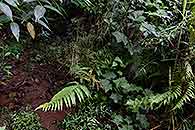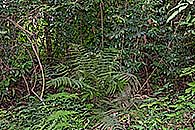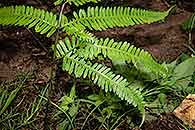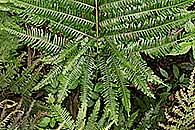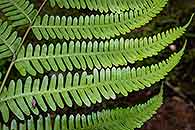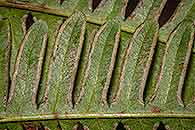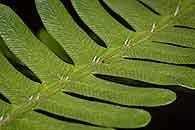Pteris friesii Hieron.
Synonyms |
Pteris quadriaurita Retz. subsp. friesii (Hieron.) Schelpe |
|---|---|
Common name |
|
Description |
Rhizome erect to prostrate, up to 15 mm in diameter; rhizome scales lanceolate, brown with dark central stripe, up to 3 mm long, ciliate. Fronds tufted, arching, slightly coriaceous. Stipe up to 60 cm long, strawcoloured to dark brown, glabrous. Lamina up to 1 × 0.8 m, ovate in outline, deeply 2-pinnatifid, basal pinnae basiscopically developed. Pinnae narrowly lanceolate, pinnatifid; ultimate lobes narrowly linear, apices rounded, margins entire; veins free, no veins anastomosing below the sinus; glabrous on both surfaces, single spine present along the costa at the junction of the costules on the uppersurface only. Rhachis glabrous, smooth. Sori linear, continuous, marginal; indusia entire, membranous. |
Notes | Can be confused with Pteris Catoptera of which the lamina has a more membranous texture, it also has spines on the costules and costae on the upper surface of the lamina. Pteris dentata has ultimate lobes with serrate-dentate margins. |
Derivation | friesii: named after Robert Elias Fries of Sweden, who participated in the Swedish Rhodesia-Congo Expedition in 1911-1912 |
Habitat | Undergrowth of evergreen forest, moist forest in more arid regions. |
Distribution worldwide | Africa, Mascarene and Comoro Islands, Seysecelles and Madagascar. |
Distribution in Africa |
Angola, Cameroon, Dem. Republic of Congo, Gabon, Guinea, Kenya, Liberia, Malawi, Mozambique, Nigeria, Rwanda, Sierra Leone, South Africa, Sudan and South Sudan, Swaziland, Tanzania , Uganda, Zambia, Zimbabwe. |
Growth form |
Terrestrial. |
Literature |
|
